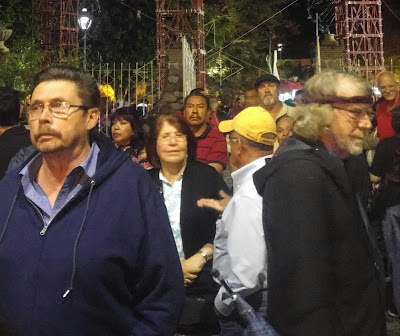 |
| As if the deceased are among us |
Day
of the Dead is observed in Ajijic and across Mexico on November 2nd.
It’s called Día
de los Muertos and I get to be a
part of it.
 |
| Creativity in honor of ancestors |
Preparations
are well underway days before.
I’m discovering that it’s not a
scary Halloween type of holiday, but rather an important family
celebration.
 |
| So colorful |
I’m
going to the edge of town where bones of ancestors are are buried. Families come together to tidy up and decorate these grave sites lavishly .
 |
| I meet a woman whose sister's baby died in 2017 |
On this day, November 1st, the children who
have died young are especially remembered. It’s
called Dia de los Muertos Ninos.
Fresh paint is applied
and flowers especially marigolds festoon the site. Food is offered. Pictures and
favorite toys for children and other mementos for adults stir
story-telling. Religious symbols abound along with colorful streamers
and other bright decorations. Each grave site becomes an artistic
creation.
 |
| Special foods and marigolds |
Time
at the graveside is not maudlin. Rather than deny death or grieve
endlessly, Mexican people have a culture of celebrating the lives of
loved ones by enjoying favorite foods, telling funny stories, singing
beloved songs and just having a good time.
It’s as if the departed
has returned for a day and the whole family turns out for the picnic.
Can you see the marigolds leading the way? Welcome home!
I
go from the cemetery to a special showing of the award winning movie,
Coco. It tells the story of a boy who on the Day of the Dead enters
the fanciful Land of the Dead in search of his Great Great
Grandfather, a legendary singer.
 |
| Living and deceased reunited in forgiveness |
Through twists and turns the story
unfolds and an appreciation of the meaning of family and Day of the
Dead deepens. I recommend it.
In
popular North American thinking, Day of the Dead is often seen as a
chance for grown-ups to paint faces in ghoulish caricature. Perhaps
fun, but not much more.
Mexican
culture is different. Historians say Day of the Dead is rooted
within indigenous culture – Aztec, Myan and others. With the
coming of the Spaniards in the 16th century, the Church
tried to ban it as pagan sacrilege. But they failed. The best they
could do was attach All Saints and All Souls Day and make peace with
Day of the Dead.
 |
| My friend, Beto, and I greet one another |
So
even through times of oppression and revolution and all sorts of
discord, Day of the Dead remains a cultural bulwark.
Deep in the
Mexican spirit is pride in family and community connections that
transcend death with unending love from generation to generation.
 |
| A marvelous sight |
Altars or Ofrendas are built in homes and around the walkways of the Central Plaza.
On the ground, artistic talent creates intricate patterns. Using flower pedals (especially marigolds) and what looks like colored sawdust, they work for hours to honor the family, living and dead.
 |
| My new friend tells me about his family |
I
meet a man on the Plaza who was born here and now lives in San Francisco. Yet, he still returns to Ajijic to greets long-time friends
at the Ofrenda of his family.
Even with me, a stranger, he tells
stories of his mother and grandparents. I’m touched deeply.
Like
Coco reminds us, family is most important. Always celebrate your
ancestors.
 |
| Beautiful designs, but only for a day |
 |
| Just having a beer |
 |
| My friend and I cozy up to Catrina |
Of
course, there are ghoulish figures in this celebration, but they
have a deeper meaning than our North American Halloween.
These
larger than life skeletal figures are called Catrinas and originated
during the late 19th century, a period of class domination.
 |
| Posing just for us |
Posada, a print maker, was distressed by the rabid corruption and
inequality of his era.
So he created an image of an extravagantly
dressed skeleton. It became a dramatic social leveler. It spoofed upper class excess and haughtiness reminding them and everyone that in the end all humans – rich or poor - become
naked bones.
Later
Catrina was embellished by the famous Mexican artist Diego
Rivera. He incorporated the image in his famous
mural
Sueño de una tarde dominical en La Alameda Central.
Over
time, Catrina lost much of its social commentary,
but it remains a reminder of human equality…not ghoulish Halloween.
It's true. We
all turn into bones. And from what I am seeing during Day of the
Dead, Mexican people love their bones and the families they belong
to.
It’s
getting late, but around the corner from the Plaza is a spectacular
display.
 |
| A part of the Wall of the Dead for the Living |
Local artist Efren Gonzales has created a mural of
bas-relief skulls attached to the outside of a long wall at a local
school. It stretches for nearly a block.
Each skull is named for an local resident, who has died , but is still remembered
 |
| Once a year candles are lite |
Each skull is named for an local resident, who has died , but is still remembered
 |
| So many everyday people |
According
to the artist, the
idea is to "honor ordinary folks" and bring them closer to the living generation.
So
if you were to join me in passing along this wall some
morning,
you would likely hear children playing within the
school yard and skulls looking forward in silent pleasure.
So
as night grows deeper, candles are lit on the grave sites at the
cemetery. People view the Ofrendas displayed on Ajijic Plaza.
And I
pause at several to say prayers and also remember my own family and
ancestors.
Maybe, they too have been lured by families remembering them, the marigolds and the
carpet of beautiful images.
Maybe they are joining with Mexican brothers and
sisters in this grand celebration. I like to think that they are....
It gives me a sweet smile to
feel….We all are living into the Day of the Dead.










